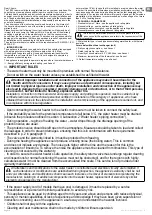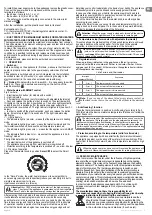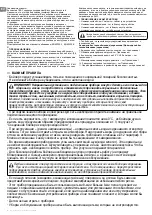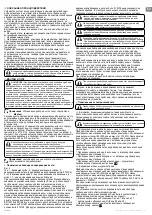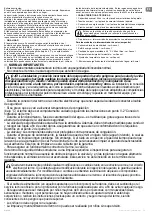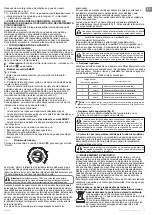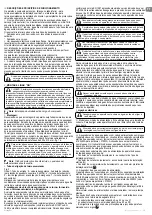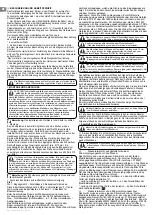
Instructions for use and maintenance
5
EN
English
Dear Clients,
The TESY team would like to congratulate you on your new purchase. We
hope that your new appliance shall bring more comfort to your home.
This technical description and instructions manual was prepared in order to
acquaint you with the product and the conditions of proper installation and
use. These instructions were also intended for use by qualified technicians,
who shall perform the initial installation, or disassembly and repairs in the
event of a breakdown.
The observance of the instructions contained herein is in the interest of
the buyer and represents one of the warranty conditions, outlined in the
warranty card.
Please consider that following the current instructions will primarily be of
interest to the consumer, but along with this, it is also one of the warranty
conditions, pointed out in the warranty card, so that the consumer can
benefit from the free warranty services. The producer is not responsible for
damages in the appliance that have appeared as a result of operation and/
or installation not corresponding to the instructions here.
The electric water heater complies with the requirements of EN 60335-1, EN
60335-2-21.
I.
INTENDED USE
The appliance is intended to supply hot water to household sites equipped
with a piping system working at pressure below 6 bar (0,6 Mpa).
It is designed to operate only in closed and heated premises where the
temperature is not lower than 4°C and it is not designed to operate in a
continuous protracted regime.
The appliance is designed to operate in regions where the water hardness is
not more than 10°dH. In case that it is installed in a region where the water
is harder it is possible that limestone precipitation accumulate very fast. This
can cause a specific noise during heating, as well as fast damaging of the
electrical part. For regions with harder water yearly cleaning of the limestone
precipitation in the appliance is recommended, as well as usage of not more
than 2 kW of heating power.
II.
TECHNICAL PARAMETERS
1.
Nominal volume V, liters - see the appliance’s rating plate
2.
Nominal voltage - see the appliance’s rating plate
3.
Nominal power consumption - see the appliance’s rating plate
4.
Nominal pressure - see the appliance’s rating plate
This is not the water mains pressure. This is the pressure that is
announced for the appliance and refers to the requirements of the
safety standards.
5.
Water heater type - closed type accumulating water heater, with thermal
insulation
For models without heat exchanger (coil)
6.
Daily energy consumption – see Annex I
7.
Rated load profile - see Annex I
8.
Quantity of mixed water at 40°C V40 litres - see Annex I
9.
Maximum temperature of the thermostat - see Annex I
10.
Default temperature settings - see Annex I
11.
Energy efficiency during water heating - see Annex I
III.
IMPORTANT RULES
•
The water heater must only be mounted in premises with normal fire resistance.
•
Do not switch on the water heater unless you established it was filled with water.
Attention! Improper installation and connection of the appliance may make it hazardous for the
health and life of consumers. It may cause grievous and permanent consequences, including but
not limited to physical injuries and/or death. Improper installation and connection of the appliance may
also lead to damage to the consumers’ property /damage and/ or destruction/, or to that of third persons,
as a result of, but not limited to flooding, explosion and/or fire.
Installation, connection to the main water and power supply, and putting into operation must be carried out by
certified electricians and technical personnel certified in installation of this category of appliances, who have
obtained their license in the state where the installation and commissioning of the appliance are carried out, and
in compliance with its local legislation.
•
Upon connecting the water heater to the electric mains care must be taken to connect the safety lead.
•
If the probability exists for the premise’s temperature to fall below 0°С, the water heater must be drained
(observe the procedure outlined in section V, subsection 2 ‘’Water heater’s piping connection”).
•
During operation – regime of heating the water – water drops through the drainage opening of the
protection valve are usual.
•
The protection valve should be left open to the atmosphere. Measures should be taken to lead and collect
the leakages in order to prevent damages, ensuring that this is in conformation with the requirements
described in p. 2 in paragraph V.
•
The valve and the elements linked to it must be protected from freezing.
•
During the heating the appliance could produce a hissing noise (the boiling water). This is common
and does not indicate any damage. The noise gets higher with the time and the reason for this is the
accumulation of limestone. To remove the noise the appliance must be cleaned from limestone. This type of
cleaning is not covered by the warranty.
•
In order to secure the water heater’s safe operation, the safety return-valve must undergo regular cleaning
and inspections for normal functioning /the valve must not be obstructed/, and for the regions with highly
calcareous water it must be cleaned from the accumulated lime scale. This service is not provided under
warranty maintenance.
All alterations and modifications to the water heater’s construction and electrical circuitry are forbidden. If
such alterations or modifications are established during inspection, the appliance’s warranty shall be null
and void. Alterations and modifications shall mean each instances of removal of elements incorporated by the
manufacturer, building in of additional components into the water heater, replacement of elements by similar
elements unapproved by the manufacturer.
•
If the power supply cord (of models that have one) is damaged, it must be replaced by a service
representative or a person with similar qualification, to avoid any risk.
•
This appliance can be used by children aged from 8 years and above and persons with reduced physical,
sensory or mental capabilities or lack of experience and knowledge if they have been given supervision or
instruction concerning use of the appliance in a safe way and understand the hazards involved.
•
Children shall not play with the appliance.
•
Cleaning and user maintenance shall not be made by children without supervision.





